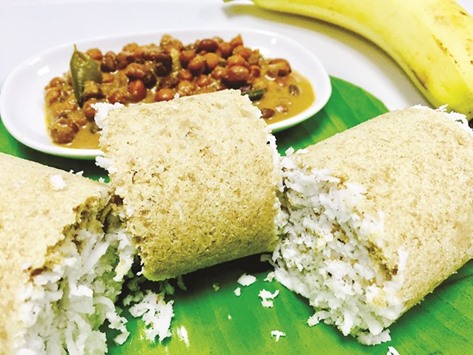When we think of South Indian food, the first few dishes that come to our mind are dosa, idli or wada with sambhar and coconut chutney. But there is a lot more to the cuisine than these common dishes.
When you travel to the south Indian states, you realise that every state has its own speciality and traditional recipes and their methods to make those recipes — for example the hot curries of Madras, the fish curries of Kerala and spicy treats of Andhra.
One such recipe that I came across when I moved to Middle East was puttu — this dish was quite popular in the region owing to the large south Indian population, mainly from Kerala.
Puttu is a traditional and most popular breakfast dish of Kerala prepared with rice flour and coconut. Puttu is usually served with black peas curry and is called kadla curry in Malayalam language. Other accompaniments are small yellow Kerala banana, sugar and crispy poppadum. When I first came across this delicious dish I was a pure idli lover and could eat idli every day for breakfast without hesitation, but after having puttu I was ready to share that spot with another south Indian dish — puttu and kadla curry.
Puttu requires a special vessel for its preparation — the puttu kutti, which is made of stainless steel or aluminium and consists of a water container at the bottom and a cylindrical steaming chamber on top.
The water container is filled half with water and is heated on gas or electric stove to make steam, the rice mixture is prepared and placed in the steaming cylindrical chamber. The perforated lids between the water container and steaming cylinder allow the steam to pass and cook the puttu. The mixture is layered with grated coconut to separate the portion and to make it easier to take out the steamed rice cylinders once they are steamed and ready to eat.
In old times, savoury puttu was steamed in bamboo tubes with pierced disc at the bottom, fixed tightly over a wide mouthed pot in which water was boiled. The sweet version was steam cooked by tying the ingredients in a thin wet cloth or wicker basket and placing it over a wide-mouthed vessel in which water was boiled.
In Tamil Nadu, the sweet version was made with jaggery as a food offering during the nine-day Navarathri festival.
It’s no secret that mixing puttu podi is either a hit or miss, especially if you are a beginner; the mixing part is the most difficult, you need to wet rice flour with water and salt correctly to get soft puttu and the trick is to add rice with water slowly with your finger tips and to know the correct texture. It should hold its shape when pressed between your fist but should crumble if pressed harder.
For a perfect soft puttu it is always advised that you get the correct texture of the mixture and it depends on how you moisten the flour. You will eventually figure out a way and will be able to make perfect mixture after making it once or twice following the recipe correctly.
So the next question that naturally comes up, is puttu healthy? And the answer is yes, one plate of steamed puttu contains approximately 300 calories, which is sufficient to satiate your senses and keep you full for a long time. A puttu is a perfect and healthy way to start your day apart from the regular south Indian fare that you are aware about.
Puttu
Ingredients
Puttu flour 2 cups
Warm water 1/2 cup
Grated coconut ½ cup
Salt ½ tsp
Method
Mix the rice flour and salt together in a bowl.
Add water a little at a time and mix with your fingertips. We are looking for a crumbly and moist flour consistency.
The mixture should hold its shape when pressed between your fist but easily crumble when you press it harder.
You need a puttu steamer to make puttu, but if you don’t have one and don’t intend to buy one soon, you can use an idli steamer.
Add about 1 tsp grated coconut to the bottom of the mould.
Spoon in puttu flour until the mould is halfway filled. Then another layer of coconut to separate and fill up with rest of the flour.
Steam for about 8-12 minutes depending on the size of your mould.
When cooked, unmould by pressing through the mould using the stem of spatula gently.
Allow to cool down a bit and serve hot with black chickpeas curry.
Note: Puttu is meant to be crumbly even after cooking, if you don’t have the time to make kadla curry, you can also have it with warm clarified butter. There is a variety of puttu flour available like the wheat, ragi or corn.

Puttu.- Photo by the author


